9 XX21 cartridges and weapons for them (Article I)
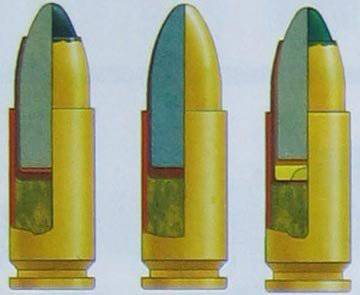 Chucks with metric designation 9h21 include the following notation: JV-10 (bullet cartridge with a steel heat-treated core enhanced penetration), JV-11 (bullet cartridge with reduced rebounding property with lead core), JV-12 (equips expansive bullet) and SP -13 (equipped with a bullet armor-piercing tracer). The development of these munitions was started at the beginning of the 90-s along with the development of a new, at that time, self-loading pistol "Vector", also known as "Gyurza", also known as ATP, also known as SR1 and so on, but about this weapon and its various options talk a little below. All cartridges 9x21 have the same external dimensions, which allows you to use them in one weapon, even mixed. Ammunition differs only in the design of bullets. The basis of 9X21 cartridges was the 9x18 PM cartridge, in which the sleeve was extended to a 21 millimeter, which in turn was made on the basis of .380ACP (9X17), developed on the basis of 9 mm Brauning Long (9X20). Designer Alexey Yuriev became the author of the ammunition data. At the moment, the cartridges adopted. If to speak as a whole, then at the time of its appearance this ammunition made quite a lot of noise, at least according to the people who found this moment and came across it. Personally, I hardly believe that a demonstration of penetration of body armor from a pistol and a submachine gun could have made a serious impression on someone (it is usually indicated that the Americans tied their hair on). Still, such a weapon in the military environment is quite specific, and, which is especially noticeable here, is a kind of tribute storiesrather than the really necessary weapons of widespread use in the army. So I don’t see any reason for concern for the likely opponent even if these cartridges pierced body armor of the fifth class of protection. However, in the US, alarmists are still the ones, so I would not be surprised if 9x21 really had a strong influence on the minds of those who were present at the demonstration.
Chucks with metric designation 9h21 include the following notation: JV-10 (bullet cartridge with a steel heat-treated core enhanced penetration), JV-11 (bullet cartridge with reduced rebounding property with lead core), JV-12 (equips expansive bullet) and SP -13 (equipped with a bullet armor-piercing tracer). The development of these munitions was started at the beginning of the 90-s along with the development of a new, at that time, self-loading pistol "Vector", also known as "Gyurza", also known as ATP, also known as SR1 and so on, but about this weapon and its various options talk a little below. All cartridges 9x21 have the same external dimensions, which allows you to use them in one weapon, even mixed. Ammunition differs only in the design of bullets. The basis of 9X21 cartridges was the 9x18 PM cartridge, in which the sleeve was extended to a 21 millimeter, which in turn was made on the basis of .380ACP (9X17), developed on the basis of 9 mm Brauning Long (9X20). Designer Alexey Yuriev became the author of the ammunition data. At the moment, the cartridges adopted. If to speak as a whole, then at the time of its appearance this ammunition made quite a lot of noise, at least according to the people who found this moment and came across it. Personally, I hardly believe that a demonstration of penetration of body armor from a pistol and a submachine gun could have made a serious impression on someone (it is usually indicated that the Americans tied their hair on). Still, such a weapon in the military environment is quite specific, and, which is especially noticeable here, is a kind of tribute storiesrather than the really necessary weapons of widespread use in the army. So I don’t see any reason for concern for the likely opponent even if these cartridges pierced body armor of the fifth class of protection. However, in the US, alarmists are still the ones, so I would not be surprised if 9x21 really had a strong influence on the minds of those who were present at the demonstration.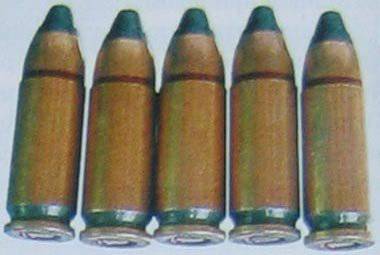 SP-10 is a cartridge with a high penetrating property, intended to destroy the enemy's manpower behind lightweight shelters or protected by personal protective equipment. The semi-internal bullet of the cartridge SP-10 has a heat-strengthened steel core, which protrudes from the shell of the bullet and is usually painted black. The core of the bullet is surrounded by a polyethylene shirt and a bimetallic sheath. The armor-piercing qualities of this ammunition are really very high for a pistol cartridge, since this cartridge provides penetration of a class III A armored vest and BR 4, according to the “non-nashenskaya” classification, and this body armor withstands the penetration of an .44 Magnum bullet, although the comparison is not entirely correct, since cartridge bullets .44 Mag and SP-10 are radically different, and the kinetic energy alone is not enough to break through body armor. However, this cartridge is taken for comparison, not because I want to show, they say how much SP-10 is better when even the bullets of such cartridges are overboard, but because this ammunition is cited as an example in tables with classes of body armor. If we talk about our body armor, then the bullet of this cartridge is able to pierce the body armor of the 2 class at a distance of up to 100 meters. By the way, you can pay attention to the fact that from our tables on body armor as an example, we took a class that provides protection against "pistol" bullets. In other words, all body armor that can protect its owner from bullets of common pistol and revolver cartridges cannot stand under the onslaught of bullets of SP-10 cartridges. Because of its design, the bullet does not have the greatest weight in 6,7 grams, while the weight of the cartridge itself is equal to 11 grams. The initial speed of the bullet is 420 meters per second. The recoil momentum of the cartridge is equal to 0.35 kgf / s.
SP-10 is a cartridge with a high penetrating property, intended to destroy the enemy's manpower behind lightweight shelters or protected by personal protective equipment. The semi-internal bullet of the cartridge SP-10 has a heat-strengthened steel core, which protrudes from the shell of the bullet and is usually painted black. The core of the bullet is surrounded by a polyethylene shirt and a bimetallic sheath. The armor-piercing qualities of this ammunition are really very high for a pistol cartridge, since this cartridge provides penetration of a class III A armored vest and BR 4, according to the “non-nashenskaya” classification, and this body armor withstands the penetration of an .44 Magnum bullet, although the comparison is not entirely correct, since cartridge bullets .44 Mag and SP-10 are radically different, and the kinetic energy alone is not enough to break through body armor. However, this cartridge is taken for comparison, not because I want to show, they say how much SP-10 is better when even the bullets of such cartridges are overboard, but because this ammunition is cited as an example in tables with classes of body armor. If we talk about our body armor, then the bullet of this cartridge is able to pierce the body armor of the 2 class at a distance of up to 100 meters. By the way, you can pay attention to the fact that from our tables on body armor as an example, we took a class that provides protection against "pistol" bullets. In other words, all body armor that can protect its owner from bullets of common pistol and revolver cartridges cannot stand under the onslaught of bullets of SP-10 cartridges. Because of its design, the bullet does not have the greatest weight in 6,7 grams, while the weight of the cartridge itself is equal to 11 grams. The initial speed of the bullet is 420 meters per second. The recoil momentum of the cartridge is equal to 0.35 kgf / s. 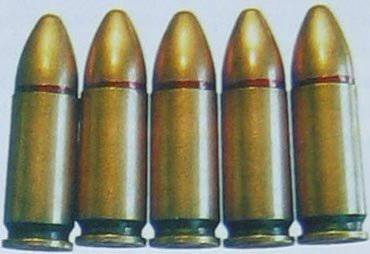 It is a well-known fact that the use of firearms in confined spaces can lead to such an unpleasant phenomenon as a ricochet. This is due to the fact that the bullet falling into the walls, floor, ceiling or objects encountered on its path does not fully give its energy to the obstacles and, reflected from them, can continue its path, but the direction of this path is almost impossible to calculate and anticipate . Thus, it is likely that a bullet will hit not the enemy, but some third person or, with a very, very low probability, the shooter himself. The main solution to this problem is either very, very low energy of a bullet, which, naturally, is not acceptable at all, or creating a bullet that is soft enough to deform very strongly when it hits an obstacle and give it almost all of its energy. However, such a bullet will become absolutely useless against any effective means of individual armor protection, although hitting a bullet in a bulletproof vest, even if it withstands, leaves few pleasant sensations. Thus, designers are faced with the task of creating such an ammunition, which is to find a balance between the relatively normal penetrating ability of a bullet and the reduced possibility of a ricochet. Among the 9 XX21 ammunition with such a bullet was SP-11. This is the most common cartridge with the usual soft bullet with a lead core, wrapped in a shell. Because of this design, the bullet cartridge lost its armor-piercing properties, but it is still enough to penetrate the 1 class body armor, but it was possible to partially deal with the ricochets. The bullet of the SP-11 cartridge, due to its design, has more weight than the SP-10, which is equal to 8 grams, the cartridge itself weighs 11,9 grams. The initial speed of the bullet dropped to 390 meters per second, and the recoil momentum of the cartridge when firing is equal to 0,37 kgf / s. This type of cartridge 9х21 does not have color markings, and in general it looks like an ordinary cartridge.
It is a well-known fact that the use of firearms in confined spaces can lead to such an unpleasant phenomenon as a ricochet. This is due to the fact that the bullet falling into the walls, floor, ceiling or objects encountered on its path does not fully give its energy to the obstacles and, reflected from them, can continue its path, but the direction of this path is almost impossible to calculate and anticipate . Thus, it is likely that a bullet will hit not the enemy, but some third person or, with a very, very low probability, the shooter himself. The main solution to this problem is either very, very low energy of a bullet, which, naturally, is not acceptable at all, or creating a bullet that is soft enough to deform very strongly when it hits an obstacle and give it almost all of its energy. However, such a bullet will become absolutely useless against any effective means of individual armor protection, although hitting a bullet in a bulletproof vest, even if it withstands, leaves few pleasant sensations. Thus, designers are faced with the task of creating such an ammunition, which is to find a balance between the relatively normal penetrating ability of a bullet and the reduced possibility of a ricochet. Among the 9 XX21 ammunition with such a bullet was SP-11. This is the most common cartridge with the usual soft bullet with a lead core, wrapped in a shell. Because of this design, the bullet cartridge lost its armor-piercing properties, but it is still enough to penetrate the 1 class body armor, but it was possible to partially deal with the ricochets. The bullet of the SP-11 cartridge, due to its design, has more weight than the SP-10, which is equal to 8 grams, the cartridge itself weighs 11,9 grams. The initial speed of the bullet dropped to 390 meters per second, and the recoil momentum of the cartridge when firing is equal to 0,37 kgf / s. This type of cartridge 9х21 does not have color markings, and in general it looks like an ordinary cartridge.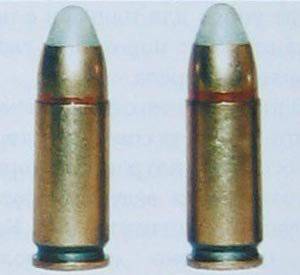 Of course, the cartridge SP-11 turned out to be quite good and can be a significant competitor to most of the ammunition used in pistols and machine pistols, but there is no limit to perfection. Since the SP-11 ammunition did not stand out for its “armor-piercing” qualities, it was decided to make it more effective when it hit the target that was not protected by anything. In addition, they decided to "kill two birds with one stone" and solve the problem with the possibility of a bullet to pass through the body of the enemy and hit the standing man from behind. The only logical solution to increase the effectiveness and reduce the length of the wound channel was to create an ammunition with an expansive bullet. Oddly enough, but on this patron, which is called SP-12, worked more than on others. At first, the variant was simply created with a half-shell bullet, later an expansive cavity appeared in the bullet and even though the effect of hitting such a bullet in the body increased many times, the ballistics of the bullet left much to be desired and did not allow the cartridge to be used at distances over 50 meters, moreover, the ballistic characteristics of all 9x21 cartridges should be at least approximately the same, so that the shooter does not need to adjust when changing the type of ammunition. To solve all these problems, it was decided to add another element in the pool that would hide its “stupid” slice. This element was a plastic tip. But all the problems that this ammunition had to solve this all the same failed, there was still a problem when feeding the cartridge when used in a submachine gun. Since, due to the fact that the designers were trying to bring the bullet of the SP-12 cartridge to the other versions of the 9x21 cartridges, the SP-12 bullet initially had a slightly different shape, as well as the length, which reduced the overall length of the munition, this became the main problem , consisting in constant utykaniyah when serving in pistols, machine guns, although in a pistol ammunition behaved quite normally. To eliminate this problem, it was necessary to virtually design a bullet from scratch, which became exactly the same as other bullets of 9x21 cartridges, although its damaging ability dropped into soft tissues slightly decreased, but the trajectory of movement almost completely coincides with other bullets. cartridges 9x21. The bullet of SP-12 cartridges is the easiest of all 9x21, its weight is only 5,7 gram, while the initial speed is equal to 400-425 meters per second.
Of course, the cartridge SP-11 turned out to be quite good and can be a significant competitor to most of the ammunition used in pistols and machine pistols, but there is no limit to perfection. Since the SP-11 ammunition did not stand out for its “armor-piercing” qualities, it was decided to make it more effective when it hit the target that was not protected by anything. In addition, they decided to "kill two birds with one stone" and solve the problem with the possibility of a bullet to pass through the body of the enemy and hit the standing man from behind. The only logical solution to increase the effectiveness and reduce the length of the wound channel was to create an ammunition with an expansive bullet. Oddly enough, but on this patron, which is called SP-12, worked more than on others. At first, the variant was simply created with a half-shell bullet, later an expansive cavity appeared in the bullet and even though the effect of hitting such a bullet in the body increased many times, the ballistics of the bullet left much to be desired and did not allow the cartridge to be used at distances over 50 meters, moreover, the ballistic characteristics of all 9x21 cartridges should be at least approximately the same, so that the shooter does not need to adjust when changing the type of ammunition. To solve all these problems, it was decided to add another element in the pool that would hide its “stupid” slice. This element was a plastic tip. But all the problems that this ammunition had to solve this all the same failed, there was still a problem when feeding the cartridge when used in a submachine gun. Since, due to the fact that the designers were trying to bring the bullet of the SP-12 cartridge to the other versions of the 9x21 cartridges, the SP-12 bullet initially had a slightly different shape, as well as the length, which reduced the overall length of the munition, this became the main problem , consisting in constant utykaniyah when serving in pistols, machine guns, although in a pistol ammunition behaved quite normally. To eliminate this problem, it was necessary to virtually design a bullet from scratch, which became exactly the same as other bullets of 9x21 cartridges, although its damaging ability dropped into soft tissues slightly decreased, but the trajectory of movement almost completely coincides with other bullets. cartridges 9x21. The bullet of SP-12 cartridges is the easiest of all 9x21, its weight is only 5,7 gram, while the initial speed is equal to 400-425 meters per second.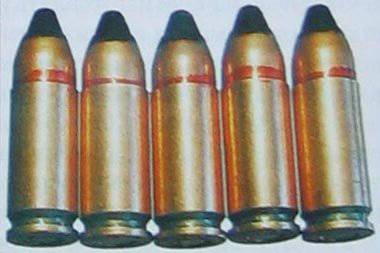 And finally, the latest version of the bullet, armor-piercing tracer, is loaded with cartridges SP-13. In general, for me personally, it remains a big mystery why it was necessary to create such an ammunition for pistols and submachine guns, since I don’t see any practical use for it, but, apparently, once done, then it is necessary. At its core, the bullet of the SP-13 cartridge differs from the SP-10 only in that it has a tracer composition pressed from the back side, but this seemingly insignificant difference seriously affected the characteristics of the munition as a whole. So the bullet has a weight of 7,1 grams, its initial speed is 395 meters per second. At the same time, the bullet has become less “armor-piercing”, but can still pierce the body armor of the 2 protection class, although with less effectiveness than the SP-10. The pressed tracer composition creates a bright luminous dot when fired from the back of the bullet, but since its speed is large enough, and the human eye, and especially the brain, the “instruments” are far from perfect, this point is perceived as a line that marks the trajectory of the bullet . Usually such ammunition is used to adjust the fire, target designation, and so on, but why did it have to be implemented in the pistol cartridge, as I said above, for me personally, it remains completely unclear. SP-13 cartridges are marked with green paint on the tip of the bullet, which is used to paint the armor-piercing core and part of the shell.
And finally, the latest version of the bullet, armor-piercing tracer, is loaded with cartridges SP-13. In general, for me personally, it remains a big mystery why it was necessary to create such an ammunition for pistols and submachine guns, since I don’t see any practical use for it, but, apparently, once done, then it is necessary. At its core, the bullet of the SP-13 cartridge differs from the SP-10 only in that it has a tracer composition pressed from the back side, but this seemingly insignificant difference seriously affected the characteristics of the munition as a whole. So the bullet has a weight of 7,1 grams, its initial speed is 395 meters per second. At the same time, the bullet has become less “armor-piercing”, but can still pierce the body armor of the 2 protection class, although with less effectiveness than the SP-10. The pressed tracer composition creates a bright luminous dot when fired from the back of the bullet, but since its speed is large enough, and the human eye, and especially the brain, the “instruments” are far from perfect, this point is perceived as a line that marks the trajectory of the bullet . Usually such ammunition is used to adjust the fire, target designation, and so on, but why did it have to be implemented in the pistol cartridge, as I said above, for me personally, it remains completely unclear. SP-13 cartridges are marked with green paint on the tip of the bullet, which is used to paint the armor-piercing core and part of the shell. In addition, there is also a training cartridge, which is devoid of powder charge and primer. It is made of cartridge SP-10, apparently differs in that approximately in the center of the sleeve there is a circular compression. It is unlikely that someone will meet the next ammunition, but it should be mentioned. In order to check the barrel locking assembly at the factory, there is another cartridge of the 9x21 family. This cartridge is called "test", has an increased powder charge. You can distinguish this cartridge from others by black paint, which completely covers the bullet. Let me remind you that in SP-10 only the bullet tip is painted black. To shove him into a weapon is extremely not recommended by the Ministry of Health, especially in submachine guns in sum using automatic firing.
In addition, there is also a training cartridge, which is devoid of powder charge and primer. It is made of cartridge SP-10, apparently differs in that approximately in the center of the sleeve there is a circular compression. It is unlikely that someone will meet the next ammunition, but it should be mentioned. In order to check the barrel locking assembly at the factory, there is another cartridge of the 9x21 family. This cartridge is called "test", has an increased powder charge. You can distinguish this cartridge from others by black paint, which completely covers the bullet. Let me remind you that in SP-10 only the bullet tip is painted black. To shove him into a weapon is extremely not recommended by the Ministry of Health, especially in submachine guns in sum using automatic firing.In my humble opinion, 9x21 cartridges are currently one of the most promising ammunition for pistols and submachine guns. It is strange only that so far not so many samples of weapons have been created for them, but I think that this situation will soon be corrected. Perhaps they have not yet tried out what kind of cartridge it is, and in production it is not cheap, but if you close your eyes to it, then 9x21 is an excellent replacement for 9x18, leaving 9x19 far behind, both for the Interior Ministry and for the army. By the way, there is a great topic for discussion under the article, because the weapon is created based on the cartridge, there is a cartridge, it remains only to create a weapon that meets the requirements, but this does not happen. Well, the fact that there is certainly a great weapon, but it is made under requirements that are clearly unacceptable everywhere, although what is, can boast of sufficient "flexibility", but here, rather, "on bezrybe and cancer fish" than you can seriously talk about the universality of weapons, even taking into account the relative diversity of ammunition. But more about that in the next article.
- Karasik Kirill
- weaponland.ru
Information